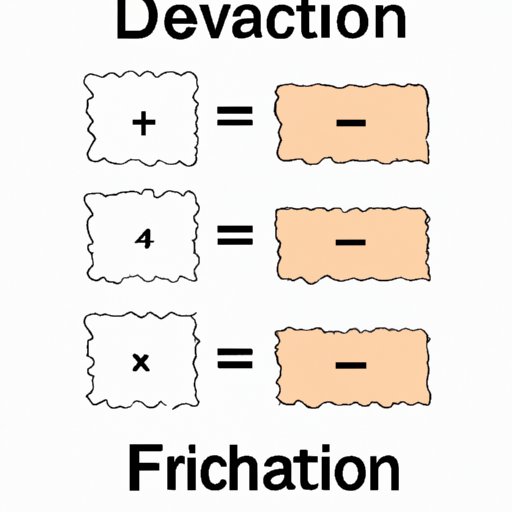
Introduction
Have you ever seen a fraction and wondered how to divide it? Dividing fractions can be tricky, especially if you are not familiar with the process. However, knowing how to divide fractions is an important skill that is useful in a wide range of situations, from cooking to engineering. This article will explore different methods to divide fractions, including step-by-step approaches, analytical methods, examples-based techniques, visual explanations, interactive exercises, and tips and tricks to make dividing fractions easier.
Step-by-Step Method
The process for dividing fractions is straightforward. To divide one fraction by another, you need to invert the second fraction (also called the divisor) and then multiply it by the first fraction (the dividend). This can be expressed by the following formula:
(a/b) ÷ (c/d) = (a/b) x (d/c)
The first step in solving fraction division problems is to convert any mixed numbers to improper fractions. Then, follow these steps:
- Invert the second fraction.
- Multiply the two fractions.
- Rewrite the answer in its simplest form.
Let’s work through an example. Suppose you want to divide 1/4 by 2/3:
- Invert the second fraction: 2/3 becomes 3/2
- Multiply the two fractions: (1/4) x (3/2) = 3/8
- Rewrite the answer in its simplest form: 3/8 is already in its simplest form
So, 1/4 divided by 2/3 is equal to 3/8.
Analytical Approach
Fraction division involves the concept of multiplying by the reciprocal. When you invert the second fraction, you are finding its reciprocal. Then, you multiply the two fractions together. This process can be explained analytically as follows:
(a/b) ÷ (c/d) = (a x 1/b) ÷ (c x 1/d) = (a x d) ÷ (b x c)
Here, you are multiplying the numerator of the first fraction by the reciprocal of the second fraction (which is d/c), and the denominator of the first fraction by its own reciprocal (which is 1/b). This yields the same result obtained in the previous method: (a x d) ÷ (b x c). Understanding this concept is key to using fraction division in real-life situations, where problems may not be presented in the same format as textbook exercises.
Examples-Based Method
To get a sense of how fraction division is used in everyday life, consider the following examples:
- If a recipe calls for 2/3 cup of flour and you want to make half the recipe, how much flour do you need?
- If a car can travel 30 miles per gallon of gasoline, how far can it go with 2/5 of a gallon?
These problems require you to divide one fraction by another to find the answer. Once you can recognize these types of scenarios, you can quickly set up and solve the corresponding fraction calculation.
For example, to halve a recipe that calls for 2/3 cup of flour:
- Convert the fraction to the amount of flour needed for the full recipe: 2/3 cup
- Divide the fraction by 2 to get the amount needed for half the recipe: 2/3 ÷ 2 = 1/3
So, you will need 1/3 cup of flour for half the recipe.
Visual Explanation
If you are a visual learner, diagrams and charts can be helpful tools for understanding fraction division. Here is an example of a step-by-step diagram for dividing 2/3 by 1/2:
1. Flip the second fraction: 1/2 becomes 2/1.
2. Multiply the two fractions together: (2/3) x (2/1) = 4/3.
3. Simplify the result: 4/3 can be reduced to 1 and 1/3.
By breaking down the process into visual steps, you can more easily follow along and remember the procedure.
Interactive Method
To reinforce your understanding of fraction division, try an online quiz or game. Some websites offer interactive exercises where you can practice solving fraction division problems and receive instant feedback on your answers. These exercises often include explanations and examples to help you improve your skills.
Tips and Tricks
Here are some tips and tricks to make dividing fractions easier:
- First, convert any mixed numbers to improper fractions. This will make the division process simpler.
- When inverting the second fraction, you don’t need to change the position of the numerator and denominator if you write the fraction vertically.
- Remember that dividing by a fraction is the same as multiplying by its reciprocal.
- If you are dividing a mixed number by a fraction, convert the mixed number to an improper fraction, invert the second fraction, and then multiply the two fractions.
Conclusion
Dividing fractions is an important skill that you can use in a wide range of situations. Whether you prefer step-by-step methods, analytical approaches, examples-based techniques, visual explanations, interactive exercises, or tips and tricks, there’s a way for you to make fraction division easier. Remember to practice regularly to improve your skills and make the most of this useful math technique.




